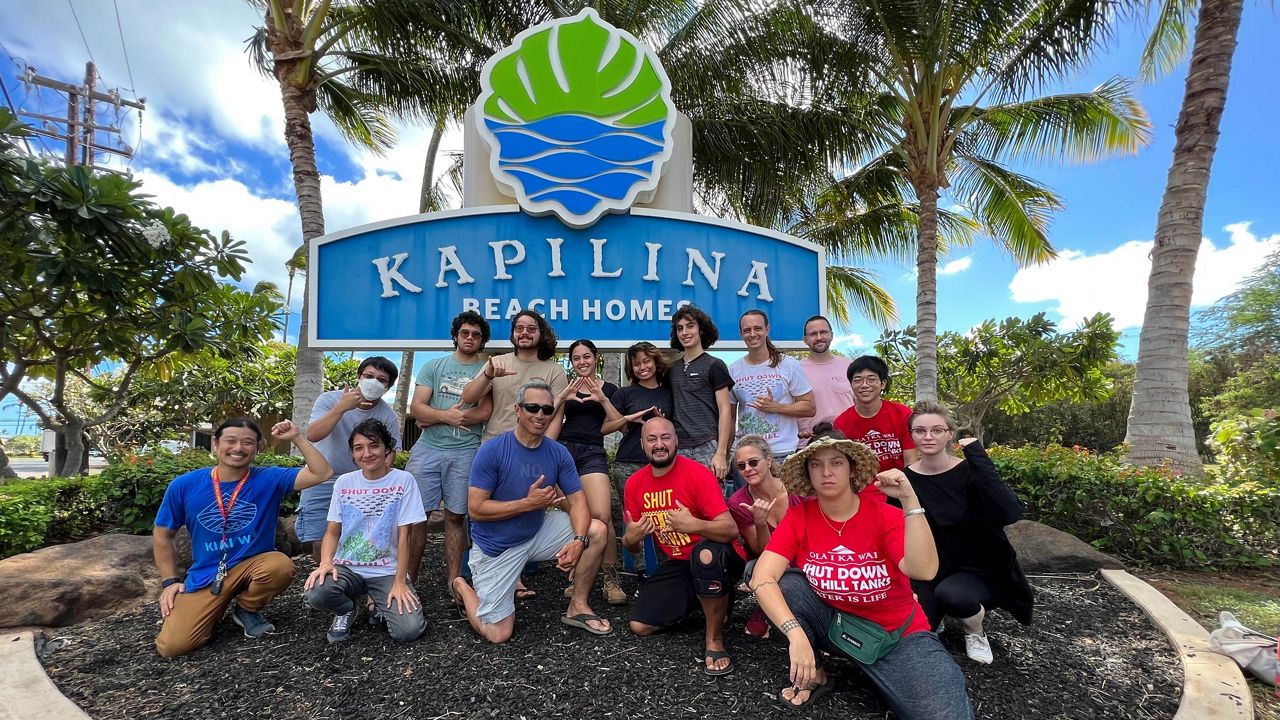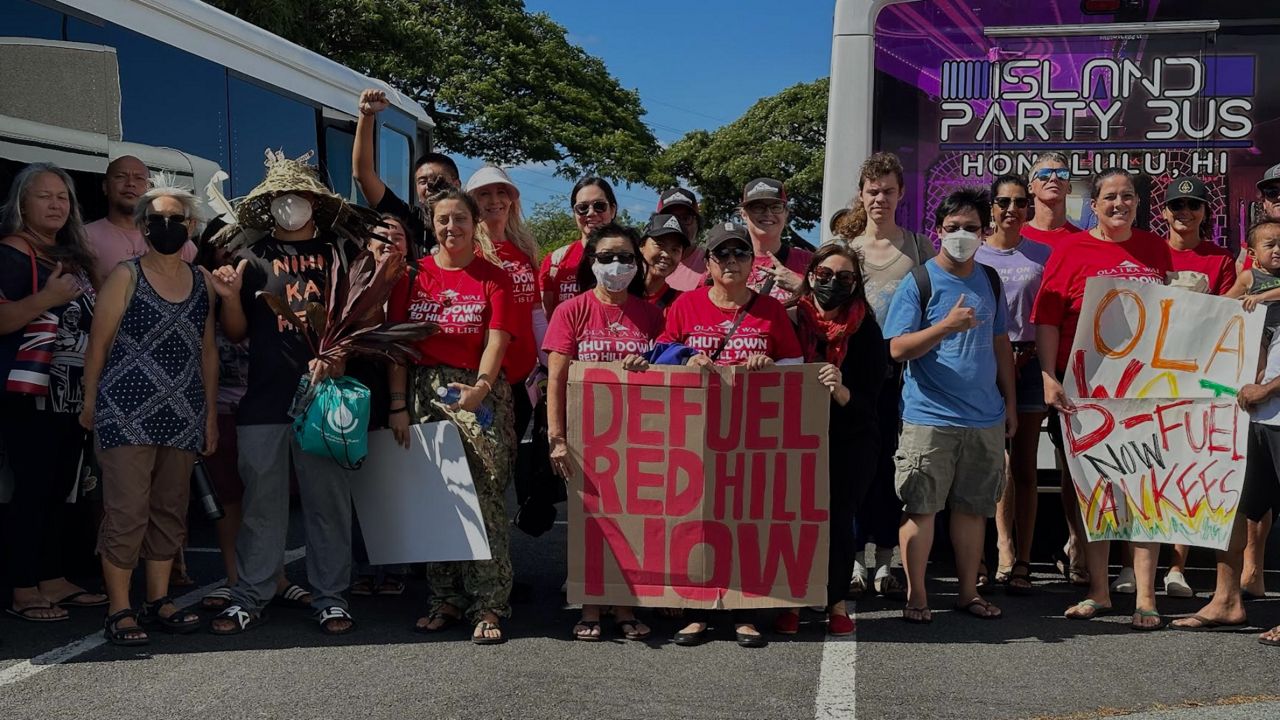HONOLULU — Activists have been holding a series of events to mark the one-year anniversary of the Red Hill fuel leaks that sickened thousands of families that live near Pearl Harbor.
At the events, which were officially marked on Sunday, Nov. 20, activists wanted to let Navy leaders know they want the Red Hill fuel tanks emptied and shut down, and as long as they continue to sit with fuel in them, the island’s aquifer is threatened. They also want the Navy to hold regular in-person meetings with the public.
The groups that helped organize the anniversary events included the Sierra Club of Hawaii, an environmental nonprofit; Oahu Water Protectors, a coalition fighting for clean water; Shut Down Red Hill Mutual Aid, an organization working to shut down Red Hill; Ka Lahui Hawaii, a Native Hawaiian organization; Faith Action for Community Equity, an interfaith nonprofit; and Shimanchu Wai Protectors, a group of Okinawan immigrants and their descendents advocating for the Red Hill crisis.
Wayne Tanaka, the Sierra Club of Hawaii executive director, said in a news release that the Navy’s timeline to remove the fuel by June 2024 is too long and that there is a threat of a structural failure or an earthquake compromising the 80-year-old Red Hill fuel tanks.
For the first event over the weekend, about three dozen activists gathered at the corner of Dole and University Avenue Friday to hold signs and print shirts. Activists have been sign-waving every Friday for months in order to spread awareness about the Red Hill crisis, and this was the last sign-waving event of 2022.
Shut Down Red Hill Mutual Aid and others met Saturday at Kapilina Beach Homes, former military housing that uses the Navy’s water system, to distribute water and supplies to affected families. The group has previously distributed water to this community, and when the Navy’s water main break occurred in October, they distributed three pallets of water.

On Sunday, more than two dozen activists served an “eviction notice” to Navy command, which was given to the gate guards at Pacific Fleet Command Headquarters. Many of the protesters had signed the eviction notice at the event on Friday.
The eviction notice cited the Navy for prioritizing wartime objectives over safety and security of the land and people of Hawaii; partaking in the overthrow of the Hawaiian Kingdom in 1893; desecrating Kapūkakī, which is the original name for Red Hill, a place Native Hawaiians consider sacred, as it is an entryway to the land of the deceased; and allegedly lying during the legal proceedings concerning Red Hill, when the Navy failed to acknowledge leaks from a Red Hill pipeline in 2020.
The activists also handed out hundreds of ice pops on Sunday at the Navy Exchange and talked with military families about the possibility of ongoing threats to their health from the water.
“People on the Navy’s water system need to be informed that there are still reports of ongoing health and contamination issues. They need to know that if they are experiencing health symptoms or observing issues with their tap water, there are resources and networks out there who may be able to help,” said Tanaka.
He said he wants the families on the Navy’s water system to know that they are all connected and that they all need to take care of one another.
While the Navy has started hosting more regular news conferences and a forum of invited community members, elected representatives, stakeholders and the Joint Task Force leadership, the organizers of the weekend’s events said in the news release that they are disappointed that the Navy is not holding regular in-person meetings with the public.
The Shut Down Red Hill Coalition has also asked U.S. Indo-Pacific Command Admiral John Aquilino and Joint Task Force Commander Rear Admiral Wade to meet them at the Makalapa Gate entrance at Joint Base Pearl Harbor-Hickam. Neither has done so.
"The buck stops at the top, and Rear Admiral Wade and Admiral Aquilino have done nothing to answer the call to meet with the people whose island, whose lives, and whose future remains in jeopardy,” Janice Toma Shiira, of the Shimanchu Wai Protectors, said in the news release.
On Monday, the military held a news conference to provide updates about the Red Hill Bulk Fuel Storage Facility for the one-year anniversary of the fuel leaks. During the meeting, Wade said he was willing to have a private conversation with Wade.
“I am more than willing to sit down with Mr. Tanaka, and have a private conversation, and a productive conversation and professional conversation. To understand his perspectives,” said Wade. “I believe that he and I actually have several things in common. The one thing I know for sure is that we both want the fuel removed from those tanks above the aquifer as safely and expeditiously as possible.”
When asked by Spectrum News Hawaii about Wade’s comment that he was willing to meet, Tanaka said, “I have not received any outreach from him at this point, however. Always happy to talk — but what we need are actions and tangible, concrete commitments. At this point fuzzy wordplay, ‘advisory committees’ and unenforceable consent orders have only given us a poisoned aquifer and contaminated water system for the housing units of 93,000 people.”
Michelle Broder Van Dyke covers the Hawaiian Islands for Spectrum News Hawaii. Email her ideas and feedback at michelle.brodervandyke@charter.com.



